英语四级快速阅读比较结果
阅读第二讲 大学英语四级快速阅读

Words that show addition 补充性过渡词
Additional words signal added ideas. These words tell you a writer is presenting one or more ideas that continue along the same line of thought as a previous idea. Like all translations, addition words help writers organize their information that present it clearly to readers.
Additional words:
One First first of all For one thing To begin with Another Second also
In addition Next Moreover Furthermore Last Last of all finally
Authors use two common methods to show relationships and make their ideas clear. 1. transition 2. patterns of organization
Transitions过渡
Transitions are words or phrases that show the relationships between ideas. They are like signs on the road that guide travelers. Two major types of transitions are words that show addition and words that show time.
大学英语四级-快速阅读做题技巧

01
文章中多次出现的语汇不是定位词。越细节越特殊的词,在文章中出现的频率越低,一旦找到,它旁边的信息应该就是考点了。
02
意题干中的定语和状语。
定语可以使一个概括性的概念更加细节化,状语可以使一个一般性的动作更加特殊化。所以,如果题干较长,又没有特殊印刷体文字的情况下,选取定语和状语中有代表性的词作为定位词,比较可靠。当然不排除主语和谓语本身就很特殊,或者考点词本身就是定位词的情况。
标点符号处常设考点
01
许多标点符号的出现是为了更好地解释前面的一些信息,所以我们可以运用标点符号(破折号、小括号、冒号等)推测不认识的词汇或句子的含义。
02
时间、数字、大写字母、斜体或一些很特别的信息点处常设考点
03
这些信息一方面很容易识别,另一方面,这些信息点一般都是文章的细节信息,容易出细节判断题。
定位词:先看问题,然后直接在原文上找问题中比较重要的单词所在,这样基本上就可以知道答案,因为问题一般都是从原文上直接摘下来的。定位词每次只需要找2-3个,多了记不住。
01
有专有名词、大写字母单词如:UNESC,为首选定位词。
02
快速阅读技巧
回视。即来回看已经读过的内容,不断反复。
C
视幅小。即所谓“抠读”。阅读时一个字一个字地看,而不是按意群读,一目数词。
04
一、快速阅读的命题规律
一、快速阅读的命题规律
根据文章的行文顺序设计考点 快速阅读的题目一般是有顺序性的,前面的题目往往对应文章前面的内容,后面的题目对应文章后面的内容。
浏览文章,略读文章标题和段落标题、各段首句和尾句,从而了解文章大意和整体结构。
读题干,理解句子的意思,并确定相应的定位词和关键词。
2013年12月大学英语四级阅读理解(附答案解析)

2014年6月大学英语四级阅读理解新题型匹配练习题练习1Part ⅢReading Comprehension (40 minutes)Section B(原快速阅读理解调整为长篇阅读理解,篇章长度和难度不变。
篇章后附有10个句子,每句一题。
每句所含的信息出自篇章的某一段落,要求考生找出与每句所含信息相匹配的段落。
)Directions: In this section, you are going to read a passage with ten statementsattached to it. Each statement contains information given in one of the paragraphs.Identify the paragraph from which the information is derived. You may choose a paragraph more than once. Each paragraph is marked with a letter. Answer the questions by marking the corresponding letter on Answer Sheet 2.How to Make Peace with Your Workload[A] Swamped (忙碌的),under the gun, just struggling to stay above water...; whatever office cliche you employ to depict it, we"ve all been in that situation where we feellike we might be swallowed up by our workload. Nonetheless many a way may be used tomanage your to-do list to prevent feeling overwhelmed. How to make peace with yourworkload once and for all goes as follows.[B] Get organized. “Clear the deadwood out of your desk and keep your office inshape, which enhances your capability to handle other tasks and raises the probability that you’ll retrieve the items you do need in a faster and easier fashion,” says Jeff Davidson who works as a work/life expert and writer of more than 50 books on workplaceissues. “When something can be disposed, let it go, given in reality most of what youretain is replaceable.” Joel Rudy, vice president of operations for PhotographicSolutions, with better than thirty years of business management experience, believesthat keepi ng organized is a must. “ Messy work areas are nonproductive in some measure. Provided that you can"t locate a document or report easily because it’s lost in a pile of mess, then you have a problematic situation,” he says. “Thereby you are supposedto take the time to tidy up your work areas and keep your important files, manuals andreports in an accessible location, which will maximize your efficiencies.”[C] Make a to-do list, then cover it up. It may sound weird, but it works, says Jessica Carlson, an account executive at Bluefish Design Studio which is an advertisingconsulting firm. Carlson urges her team to utilize to-do lists to stay on track andhi ghlight items that are a priority. “Cover up the list, with the exception of onehigh-priority task at one time,” she suggests. “This will allow you to focus betteron the task at hand; otherwise, it will be easy to get overwhelmed if you’re reading through a to-do list that spans an entire page. Concentrating on a single item will make your tasks appear like they are more doable,” Carlson says.[D] Stop multitasking. Despite what you may consider multitasking, it’s counterproductive. Unless you’re drinking coffee while scanning your morning e-mails, you’re not saving any time by attempting to do ten things at once. “If you find yourself getting tangled in too many things, it may be of much necessity of you to re-evaluateyour involvement,” Rudy says. “Your mind will wander from one topic to another andyou may end up never accomplishing a thing.” Rudy recommends the best way to stop multitasking is to create priority lists with deadlines. “When applicable, completeone project before you move further on to the next one,” he says.[E ] Set time limits. Deborah Chaddock-Brown, a work-at-home single parent, saysshe’s frequently overwhelmed by the demands of maintaining order in her residence and running her own business. Still, she manages to “do it all” by setting a time limitfor each task. “I have the type of personality that flits (轻轻地掠过)from thing to thing because I do have so much on my plate,” Brown says. “As a consequence I assigntime slots: For the next 15 minutes I will participate in social media for the purposeof marketing my business (not sending photos or playing Farmville) and that is the only thing I am about to do for the next 15 minutes. When the time is up, I move on to thenext task. That way, at night I don’t end up with a pile of tasks to accomplish eventhoug h I felt busy all day.”[F ] Talk to your manager. “Quite often, people are working on things that are nolonger a top priority, but someone forgot to tell them (that they’re no longer important). There are usually clear priorities in the manager’s head; he or she has just not donea great job communicating those with the employee,” says Holly Green, CEO o f The Human Factor. Green’s suggestion unfolds in this manner: “If you find yourself confrontedwith too many responsibilities, sit down, note the significant things you are in charge of, and go to your manager to have a conversation to discuss priorities, trade-offs,time commitments and interdependencies required to do each thing well, and then ask what you should stop working on or work on less so you can get the right things done.” Green says managers should be willing to help sort out priorities, so long as employees havea can-do approach and aren’t just complaining about their workload.[G ] Eliminate time wasters. “If interruptions are keeping yo u from your responsibilities, learn how to deal with them accordingly,” says Eileen Roth, authorof Organizing for Dummies. Roth proposes the following suggestions to combat disruptions: “Use voice mail to cut down on telephone interruptions, turn off the alert that says‘You’ve got an e-mail; and give staff members a set time to visit you.” Justin Gramm, president of Globella Buyers Realty, exemplifies Roth’s point. “E-mail had been a big time waster for me in the past because it was a constant interruption, causing me tolose focus on the task at hand,” he says. Since determined to check his e-mails only twice a day, Gramm says he has become much more efficient. “If people want to get more work done, they need to stop checking e-mails and get down to busin ess,” he says.[H] Assess your workload before taking on new tasks. “The paradox of today’s work environment is that the more you do, the more that’s expected of you,” Davidson says.In order to better assess your workload, Davidson suggests asking yourself the following questions before agreeing to undertake new responsibilities: Is the task aligned (使一致)with your priorities and goals; Are you likely to be as prone to saying yes to such a request tomorrow or next week; What else could you do that would be more rewarding;What other pressing tasks and responsibilities are you likely to face; Does the otherparty have options other than you; Will he or she be crushed if you say no?[I] Want to know more? Most of our experts recommended books for additional tipson how to maximize efficiency, but one book was mentioned time and again. Check out The Seven Habits of Highly Effective People.46. “The more you do, the more you are expected to do” has been a paradox in today’s work environment.47. As long as employees have a can-do attitude and do not just complain about their workload, the managers would like to help them decide what to do first.48. As a single parent, Deborah Chaddock-Brown finds it difficult to make a balance between business and housework.49. There are many useful methods of preventing people from feeling overwhelmed by workload.50. Messy work areas are nonproductive to some extent, so you are supposed to keepyour work areas tidy and important files at hand.51. To know more about how to maximize efficiency, The Seven Habits of HighlyEffective People is recommended.52. In Organizing for Dummies, using voice mail to cut down on telephoneinterruptions and turning off the e-mail notice are suggested in combatinginterruptions.53. According to Rudy, the best way to stop multitasking is to make a list ofpriorities and set deadlines for each task.54. Focusing on a single matter will make your tasks appear more possible to be done.55. In fact, most of what people retain is substitutable, so dispose the things that are disposable.练习2Part Ⅲ Reading Comprehension (40 minutes)Section B(原快速阅读理解调整为长篇阅读理解,篇章长度和难度不变。
英语四级快速阅读技巧优秀5篇

英语四级快速阅读技巧优秀5篇快速阅读,是英语四级考试当中,会遇到的一种题型,那么怎么才能够做好呢?下面是书包范文为您精心整编的英语四级快速阅读技巧优秀5篇,希望能够对大家的写作有一点启发。
两大基本考点,skimming和scanningSkimming,略读略读,顾名思义就是要求考生在较短时间内把握住文章一些段落的主题思想。
Scanning,跳读跳读其实对大家来说就比较熟悉了。
首先是找准题干关键词,然后带入原文定位寻找答案。
段落中与关键词无关部分可以一概略去不看。
每次快速阅读考试都有几个直接定关键词就能得答案的送分题。
建议考生可以按照“三步走”的思路来进行解题:1、浏览大标题和小标题(了解文章主题结构)2、精读文章的开头(准确把握文章的主题)3、看一题做一题,关键词定位配合顺序原则附例题:Like a needle climbing up a bathroom scale, the number keeps rising. In 1991, 15% of Americans were obese(肥胖的); by 1999, that proportion had grown to 27%。
Youngsters, who should have age and activity on their side, are growing larger as well: 19%of Americans under 17 are obese. Waistbands have been popping in other western countries too, as physical activity has declined and diets have expanded. By and large, people in the rich world seem to have lost the fight against flab(松弛)。
大学英语四级考试解题攻略——阅读篇
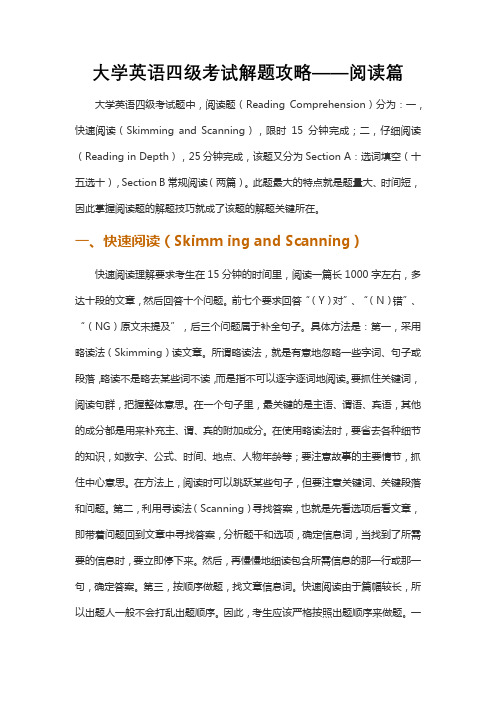
大学英语四级考试解题攻略——阅读篇大学英语四级考试题中,阅读题(Reading Comprehension)分为:一,快速阅读(Skimming and Scanning),限时15分钟完成;二,仔细阅读(Reading in Depth),25分钟完成,该题又分为Section A:选词填空(十五选十),Section B常规阅读(两篇)。
此题最大的特点就是题量大、时间短,因此掌握阅读题的解题技巧就成了该题的解题关键所在。
一、快速阅读(Skimm ing and Scanning)快速阅读理解要求考生在15分钟的时间里,阅读一篇长1000字左右,多达十段的文章,然后回答十个问题。
前七个要求回答“(Y)对”、“(N)错”、“(NG)原文未提及”,后三个问题属于补全句子。
具体方法是:第一,采用略读法(Skimming)读文章。
所谓略读法,就是有意地忽略一些字词、句子或段落,略读不是略去某些词不读,而是指不可以逐字逐词地阅读。
要抓住关键词,阅读句群,把握整体意思。
在一个句子里,最关键的是主语、谓语、宾语,其他的成分都是用来补充主、谓、宾的附加成分。
在使用略读法时,要省去各种细节的知识,如数字、公式、时间、地点、人物年龄等;要注意故事的主要情节,抓住中心意思。
在方法上,阅读时可以跳跃某些句子,但要注意关键词、关键段落和问题。
第二,利用寻读法(Scanning)寻找答案,也就是先看选项后看文章,即带着问题回到文章中寻找答案,分析题干和选项,确定信息词,当找到了所需要的信息时,要立即停下来。
然后,再慢慢地细读包含所需信息的那一行或那一句,确定答案。
第三,按顺序做题,找文章信息词。
快速阅读由于篇幅较长,所以出题人一般不会打乱出题顺序。
因此,考生应该严格按照出题顺序来做题。
一般第一题到文章前面找答案,最后一题到文章后半部分找答案。
信号词常用来连接细节或是强调内容,并可完成段落的转换,暗示读者下文要讲的内容,标志出作者要提出一个新的思想或者观点,或者是作者要对所论述的观点举例说明,或者要详细论述同一观点。
英语快速阅读测试结构效度研究——以2007年6月CET-4快速阅读部分为例

【 要】 摘 大学英语 四级考试( E 一 ) c T 4 中的快速 阅读测试 目的是 测量 学生的快速 阅读能力。 考试 结果不能直接 显示考生获得正确答案 但是
的途径 。 本文 以 2 0 年 6 C T 4快速 阅读部分为例 , 07 月 E一 通过调 查问卷 获取 了考生的快速阅读考试答题情况数据 ; 数据分析肯 定了此次考试的 结构效度 , 同时也发现考生存在 对题 目 指令误解的现象。
科技信 息
0本刊重稿 O
S I N E&T C N L G F R A I N CE C E H O O YI O M T O N
21 年 01
第 3 期 1
英语快速阅读测试结构效度研究
以 20 年 6月 C T 4 07 E 一 快速 阅读部 分为例
卜囡囡 ( 上海 电机 学 院外 国语 学 院 中国 上海 2 10 ) 0 3 6
行分析。即刻 内省法是指测试任务结束后立 即汇报答题过程 由于录 音设备有限 , 本次实验采用 了调查问卷 , 考生在答题结束后 . 即填写 立 注: 据统 计和 分析过程 中将不 区分 策略 A、 、 D, 数 B C、 而是 统一 以“ 有效 自我汇报性调查 问卷 . 报告每一道题 目的答题策略或技巧 本实验研 快速 阅读策略 ” E p c dFs Red gS a g , ( x et a e t ai t t y 以下简称 E Rs 进行 统计 ; n re F ) 不 究问题如下 : 考生在快速阅读测试中的阅读 和答题行 为是 否与 C T 4 E 一 属 于此范畴的答题 方法在 本实验 中统 称“ 应试技巧 ” n C n iu r T s ( — o tb t y e — No r o t 命题人预期的答题行为相符7
(英语四级经验)大学英语四级阅读理解经验技巧

大学英语四级阅读理解经验技巧在大学期间,很多的高校都会让学生通过英语四级考试,然而很多的学生却认为英语四级考试不好通过,原因在于阅读理解方面。
下面是由我给大家带来的大学英语四级阅读理解经验技巧,一起来看看吧!大学英语四级阅读理解经验技巧1.先去看英语阅读中的问题和答案,对于重要的词语做上标记,并写上词语的意思,然后回到原文中去匹配。
如果原文中哪一段包含的关键词与题干中划出的关键词的匹配度越高,那么那一段为正确答案段的概率也就越高。
2.快速阅读文章第一、二段,抓住文章大意、背景,因为一般会在文章开头几段概述全文。
所以在开头的时候先去弄明白文章大致讲了什么意思,对全文来说帮助会很大。
3.找到问题的答案的时候再三确认,缩小阅读范围,直到找出正确的答案。
4.仔细阅读是缺少不了的,我们在做题的时候,经常会用到排除法,有时候在阅读题里面会有一些干扰的答案,对于不太确定的时候,我们再回到原文章去找答案。
大学英语四级备考的5条经验一、词汇词汇是根底,英语要想拿高分,一定要背单词,除了背单词或者手册外,可以通过做真题积累一些高频词汇,记在笔记本上,以便能够时常翻看,一些单词书上如果有例句的话,可以在例句中背单词,还可以积累一些同义替换的词语,在写作或翻译时常会用到。
如果出现下面两种情况一定要好好背单词,比方,阅读时是不是因为不认识的单词太多而不理解文章意思,还有,在写作文时,是不是想好句子但是想不起对应词汇,如果词汇量不太够的话一定要好好背单词,因为单词是英语复习的根底。
在考前一周内,一定要将单词再系统的背一遍,如果有问题还可以再背一下例句。
二、听力要针对听力题型进行练习,每次都进行针对练习,但是一定要在规定的时间内做完,听力最重要的是要注意力集中,然后保证练习量,先看选项,用笔标出重点,在做对话题时简单做笔记。
三、阅读长阅读看选项,找出关键词,再在原文中找答案。
在规定的时间内答题,仔细阅读的话有些先看全文,有些先看选项。
CET4-6阅读:快速阅读

值得注意的是,除了在阅读理解中运用略读法和寻读法之外,有时还需要仔细阅读文章的某一特定部分,力求对其有较深的理解,或对其进行归纳、总结、推断等,这时就需要对这部分进行仔细阅读,理解作者的言外之意。这种仔细的阅读方法就是研读法(study reading),通常适用于推断型阅读理解试题。这种方法在快速阅读中使用并不多,但它对于快速阅读的解题方法来说绝对是一个有力的补充。
略读(或称为跳跃式阅读)(skimming)的重点在于快速了解文章的中心思想。略读的方法是首先看一下标题(在有标题的情况下)。接着读第一段,抓住中心思想。再浏览一下其他段落的首句和末句。最后读完结尾段。
寻读的重点在于有目标地去找出文中某些特定的信息。寻读时,要以很快的速度扫视文章,确定所查询的信息范围。同时明确查询信息的特点。如:问题或选项中所涉及到的人名、地名,则主要寻找首字母大写的单词;有关日期、数目的问题,则主要查找具体数字;有关某个事件、某种观点等,就需要寻找与此相关的关键词,而与所查信息无关的内容可一掠而过。
Above all, the interstate system provides individuals with what they cherish most: personal freedom of mobility.
问题中的“The great”就相当与原文中的“Above all”,所以答案就在该句中的冒号之后的信息:“personal freedom of mobility.”
三:基本要求
1. 快速阅读的文章基本都是专业题材的文章,很多考生可能会觉得很陌生,但是对于CET-4的快速阅读开始来说,只要求考生对题目所提到的信息在原文中能够找到即可,只是有时需要简单的同义词替换
大学英语四级快速阅读测试题及答案
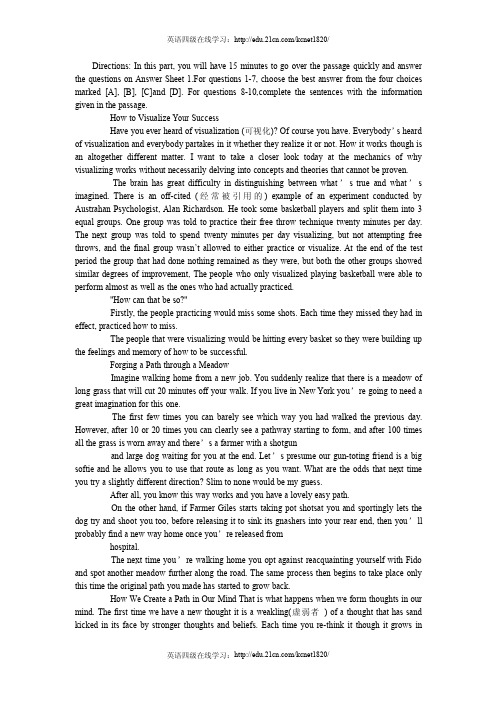
Directions:In this part,you will have15minutes to go over the passage quickly and answer the questions on Answer Sheet1.For questions1-7,choose the best answer from the four choices marked[A],[B],[C]and[D].For questions8-10,complete the sentences with the information given in the passage.How to Visualize Your SuccessHave you ever heard of visualization(可视化)?Of course you have.Everybody’s heard of visualization and everybody partakes in it whether they realize it or not.How it works though is an altogether different matter.I want to take a closer look today at the mechanics of why visualizing works without necessarily delving into concepts and theories that cannot be proven.The brain has great difficulty in distinguishing between what’s true and what’s imagined.There is an off-cited(经常被引用的)example of an experiment conducted by Austrahan Psychologist,Alan Richardson.He took some basketball players and split them into3 equal groups.One group was told to practice their free throw technique twenty minutes per day. The next group was told to spend twenty minutes per day visualizing,but not attempting free throws,and the final group wasn’t allowed to either practice or visualize.At the end of the test period the group that had done nothing remained as they were,but both the other groups showed similar degrees of improvement,The people who only visualized playing basketball were able to perform almost as well as the ones who had actually practiced."How can that be so?"Firstly,the people practicing would miss some shots.Each time they missed they had in effect,practiced how to miss.The people that were visualizing would be hitting every basket so they were building up the feelings and memory of how to be successful.Forging a Path through a MeadowImagine walking home from a new job.You suddenly realize that there is a meadow of long grass that will cut20minutes off your walk.If you live in New York you’re going to need a great imagination for this one.The first few times you can barely see which way you had walked the previous day. However,after10or20times you can clearly see a pathway starting to form,and after100times all the grass is worn away and there’s a farmer with a shotgunand large dog waiting for you at the end.Let’s presume our gun-toting friend is a big softie and he allows you to use that route as long as you want.What are the odds that next time you try a slightly different direction?Slim to none would be my guess.After all,you know this way works and you have a lovely easy path.On the other hand,if Farmer Giles starts taking pot shotsat you and sportingly lets the dog try and shoot you too,before releasing it to sink its gnashers into your rear end,then you’ll probably find a new way home once you’re released fromhospital.The next time you’re walking home you opt against reacquainting yourself with Fido and spot another meadow further along the road.The same process then begins to take place only this time the original path you made has started to grow back.How We Create a Path in Our Mind That is what happens when we form thoughts in our mind.The first time we have a new thought it is a weakling(虚弱者)of a thought that has sand kicked in its face by stronger thoughts and beliefs.Each time you re-think it though it grows instrength as the physical pathway becomes more and more well-defined.Not only that,but if it is a belief that contradicts one you already hold,the older belief starts to atrophy and die.This also explains why we have the same thoughts over and over again and why people have difficulty snapping negative loops(循环)of thinking.The pathway has been established and it’s just easier to continue following it than trying to thinkabout something new and form a new connection in the brain.Making Visualization Work for YouVisualization is an incredibly successful and simple way of speeding up the process by fooling the unconscious into believing that you have already done something before you have. That’s what the basketball visualizers were doing,fooling their own unconscious into thinking they know how to hit basket after basket.Of course this in and of itself will not turn you into an NBA star,you do actually have to practice as well,but it will help you succeed more quickly.All you need to do to be successful at this is to visualize yourself doing something,as you would like to do it.Profound stuff,huh?Seriously though,that is all there is to it.How long you do it each day will affect the speed of change and it’s reallynot advisable visualizing your success for20minutes per day and then spending10 hours worrying about failing and replaying negative stuff in your head.It kind of defeats the object.You can also incorporate the"fake it till you make it"method in with your visualization to help speed up the process.This is simply a matter of pretending you are already proficient at something before you really are.Again,it’s simply a way of tricking your unconscious and getting it to do what you want it to do.Some people have difficulty with this process and tell me it’s being unrealistic.Well yeh,maybe they’re right,but who cares?If you want to be shackled by the chains of realism then go ahead,knock yourself out,but let me tell you this.There are few highly successful people out there that haven’t used this method or visualization at one time or another.In fact,successful people don’t care too much for reality;it just gets in the way and slows them down.What about you?注意:此部分试题请在答题卡1上作答;8-10题在答题卡1上。
大英四级-快速阅读SkimmingandScanning
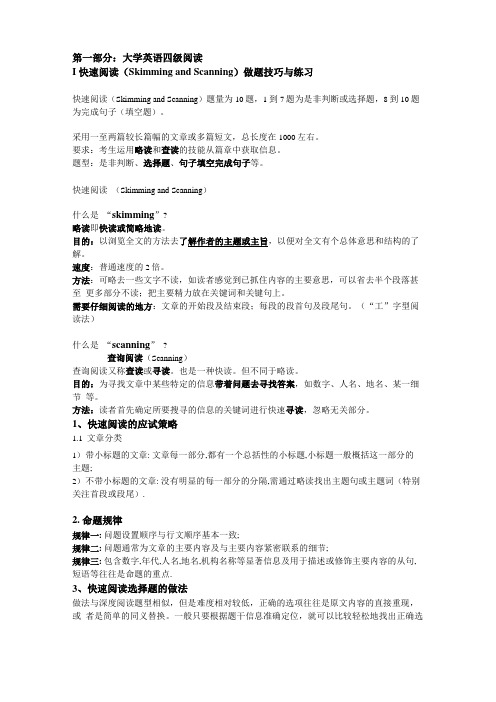
第一部分:大学英语四级阅读I 快速阅读(Skimming and Scanning)做题技巧与练习快速阅读(Skimming and Scanning)题量为10题,1到7题为是非判断或选择题,8到10题为完成句子(填空题)。
采用一至两篇较长篇幅的文章或多篇短文,总长度在1000左右。
要求:考生运用略读和查读的技能从篇章中获取信息。
题型:是非判断、选择题、句子填空完成句子等。
快速阅读(Skimming and Scanning)什么是“skimming”略读即快读或简略地读。
目的:以浏览全文的方法去了解作者的主题或主旨,以便对全文有个总体意思和结构的了解。
速度:普通速度的2倍。
方法:可略去一些文字不读,如读者感觉到已抓住内容的主要意思,可以省去半个段落甚至更多部分不读;把主要精力放在关键词和关键句上。
需要仔细阅读的地方:文章的开始段及结束段;每段的段首句及段尾句。
(“工”字型阅读法)什么是“scanning” ?查询阅读(Scanning)查询阅读又称查读或寻读。
也是一种快读。
但不同于略读。
目的:为寻找文章中某些特定的信息带着问题去寻找答案,如数字、人名、地名、某一细节等。
方法:读者首先确定所要搜寻的信息的关键词进行快速寻读,忽略无关部分。
1、快速阅读的应试策略1.1文章分类1)带小标题的文章: 文章每一部分,都有一个总括性的小标题,小标题一般概括这一部分的主题;2)不带小标题的文章: 没有明显的每一部分的分隔,需通过略读找出主题句或主题词(特别关注首段或段尾).2. 命题规律规律一: 问题设置顺序与行文顺序基本一致;规律二: 问题通常为文章的主要内容及与主要内容紧密联系的细节;规律三: 包含数字,年代,人名,地名,机构名称等显著信息及用于描述或修饰主要内容的从句, 短语等往往是命题的重点.3、快速阅读选择题的做法做法与深度阅读题型相似,但是难度相对较低,正确的选项往往是原文内容的直接重现,或者是简单的同义替换。
大学四级考试分数的换算表

大学四级考试分数的换算表听力部分(满分35分-------换算后分数248.5分):1传统听力部分(共25题)内容:短对话,长对话,短文听力换算方法:每题算1个,共25个;2听写部分(共11题)内容:单词填写,复合式句子听写换算方法:单词2题算1个,句子每题算2个,共10个;总计:35道题(我们传统意义上的35分)阅读部分(满分35分----换算后分数248.5分)1快速阅读部分(共10题)内容:7道选择题,3道结合文章填空题换算方法:10道题全部每个算1题,共10个2传统阅读部分(共10题)内容:2篇大阅读,每个5题,共10个换算方法:10道题全部每个算2题,共20个3选词填空部分(共10题)内容:为10个空选择合适的词汇换算方法:每2个空算1个,共5个总计:35道题(我们传统意义上的35分)由此可见,按照这种方法换算分数。
听力和阅读的换算标准应该是一样的。
(因为这个方法是按照答对几道题来换算的,而听力和阅读的总题数都是35道)以下就是听力及阅读的标准分换算表标准分(换算后的得分)=得分某10某0.35答对得分标准分3571248.534682383365227.53263220.53161213.53059206.52957199.52855192.52753185.52651178.525501752449171.52247164.5 2146161 2045157.5 1944154 1844154 1743150.5 1642147 1541143.5 1440140 1339136.5 1238133 1137129.5 1036126 936126 835122.5 734119 634119 533115.5331108.5230105130105029101.5综合测试部分(满分15分------换算后得分106.5分) 1完形填空部分(共20题)内容:20个选择题换算方法:每2题算1个,共10个2翻译部分(共5题)内容:5个根据要求填写的句子翻译题换算方法:每题算1个,共5个总计:15个(我们传统意义上的15分)以下是综合测试部分的标准分换算表标准分(换算后的分数)=得分某10某0.15答对得分标准分1571106.51467100.5136394.5115785.510548195176.58487274567.56426353958.543755.533552.523349.513146.502943.5写作部分(满分10分-----换算后得分106.5分)公式:得分某10某0.15=标准分(106.5~43.5分)以下是“得分”的一般性标准:33分--条理不清、思路紊乱,语言支离破碎或大部分句子均有错误,且多数为严重错误。
2023年四级 section b 快速阅读

2023年四级 section b 快速阅读随着社会的发展和经济的全球化,英语已经成为人们交流和学习的必备工具,因此英语四级考试对于大部分大学生来说是一件非常重要的事情。
在四级考试中,快速阅读是一个非常重要的部分,它不仅考察了考生的阅读能力,还考察了考生的语法和词汇的运用能力。
对于快速阅读这一部分的复习和备考是非常重要的。
一、了解题型在快速阅读部分,一般会出现两种题型,一种是选择题,另一种是判断题。
选择题主要考察考生对文章内容的理解能力,判断题则主要考察考生对文章中细节的理解能力。
在备考时,可以通过做一些历年真题来了解考试中这两种题型的具体要求,从而有针对性地备考。
二、阅读技巧1. 预览题目在考试开始前,考生应尽量预览一下题目,了解文章大意和主题,尤其是题干中的关键词,这样在阅读文章时就能更加有针对性地寻找答案。
2. 控制阅读时间快速阅读考试时间一般都比较紧张,因此考生需要控制好阅读的速度,注意阅读效率。
不要花太多时间在某一个细节上,可以先浏览整个文章,先找出题目的关键信息,然后再有针对性地进行阅读。
3. 理清思路在做选择题时,需要根据文章的主题和中心思想结合选项,进行整体比较,最后再做出选择。
而在做判断题时,需要找出文章中的关键句,然后进行判断。
4. 注意表达方式在文章中,有时会出现一些表达方式较为隐晦的句子,这时候考生需要根据上下文和逻辑推理来理解句子的含义,做出正确的判断。
三、学习方法1. 多读多练提高阅读理解能力最重要的方法就是多读多练,可以选择一些高质量的英文文章进行阅读练习,培养自己的阅读速度和理解能力。
也可以做一些快速阅读的练习题,查漏补缺,找出自己在阅读理解方面的不足之处。
2. 积累词汇快速阅读中有时会出现一些生词和难点词汇,因此平时需要坚持记忆和积累词汇,尤其是一些常见的词汇和短语,这样在考试时就能更加游刃有余地理解文章。
3. 锻炼语法和逻辑思维能力快速阅读考察的不仅仅是词汇和阅读理解能力,也涉及到了语法和逻辑思维能力。
英语四级各题解答技巧

英语四级各题解答技巧快速阅读首先的题为快速阅读,一般有用准确的方法为先读题勾关键再快速阅读课文勾关键得答案。
听力接着是听力,先利用播音员读题的三分多钟看完题并快速勾出选择题关键再听得出答案。
(切记听不懂也不要慌而狠心不听了,听不懂,就必须要装懂,(稳重些,不要受到旁边人的影响,因为他们也没有听懂!!)选择你开始听到句子的反义的句子一般是对的,你还可以依据问题猜测对话的情景,猜测出题人怎样设置的"陷阱'比如:4:40,你听到的是four past forty但是答案却是twenty to five 。
听短文关于听短文,在播音员读题的时间看一下文章,读第一遍时先不答题,集中精力记住空应填的单词,读第二遍时再书写单词。
关于听力写句子,一般是听第一遍时就填上你听到的,由于你去写第一个句子了,那第二个句子就放弃吧,然后直接写你听到的第三个句子(记住,即使你没有听完整,听到多少你就写多少,都有分的)。
听力完后后迅速进入阅读理解,别再去想句子!没时间!后面的题做法和你高考一个样!只是速度快点!快刀斩乱麻!不然做不完。
速战速决!阅读理解关于阅读理解,方法就是:读题勾出关键读文章勾题目提及的内容再回到题目找你在文中对应勾画的关键选择答案搞定!完型填空。
关于完型填空,很简单的,争取在十分钟之内。
文章一般读两遍,第一遍填上符合逻辑的,(语法题只有一个左右,不必纠缠语法,ok!)第二遍再补上剩下的空。
关于翻译,你按照你平常的翻译来了,尽量做,一般做了就有分!不要因为你翻译不完整之类的原因就直接放弃!新版的已经取消,所以这里就没必要担心了,但我还是写出来。
写作。
关于写作,比较重要的就是考前的抱佛脚了,这时候应该记一些句子,这些句子很好的,也就是优美的句型,这些句型你在多种话题中都能够套用就好,关于高手而言,写作布局现于这种方法,可以去看看更高级的比如〔托福〕〔雅思〕等的写作,提升写作的欧美风思维,这样更容易的高分。
英语四级新题型快速阅读技巧

英语四级新题型快速阅读技巧英语四级新题型快速阅读技巧英语四级新题型快速阅读技巧1、快速阅读技巧第一步:快速浏览,并判断大标题内容,确定文章主题当我们身处考场的时候,平静了自己的心情后,并准备开始对阅读理解题进行答题的时候,这个时候,你拿到了阅读理解题,就先要按照顺序开始作题。
这个时候,你要先快速浏览这个题,在浏览的时候,一定要抓住几点,那就是分析大标题所需要让你明白的目的。
对于我们自己来讲,遇到一个阅读的题的时候,看到了题目就自然而然地会想到这个题目的主要内容会是什么,所以,你拿到英语的阅读理解的时候,也是一样的,用母语的方式去分析一下,这个题它到底给了大题目后,会讲些什么主要的内容。
拿一个具体的例子来讲,例如我们拿到了一个阅读的题目里有一个词是Landfills,那么我们就要分析这个词,实际是什么意思。
Land+fill,土掩埋,会是什么?调动一切思维,那肯定是与环境有关的,那就是垃圾填筑地。
第二步:阅读小标题,了解内容,把握结构看过了大的标题,接下来的任务,就是要直接看小标题了。
对于小标题而言,就如我们中国的分段文章的总结句,这个时候,我们要看一下小标题与小标题之间的关系,例如是递进的,还是并列的,还是论述的关系,这样,我们就会对文章的结构有一个概括性的认识。
而且也可以根据小标题的具体内容来判断一下文章的主要内容。
还是根据刚才的那个单词,我们看到小标题之后,就会判断出,他们之间的联系,我们就会看到,例如处理垃圾的方式,处理垃圾的建议和计划,处理过程是如何动作的等。
好了,知道了小标题间的联系后,我们就开始判断文章的结构了。
了解文章的结构,完全可以帮助我们答题时进行定位,例如上面讲的就是,引起话题,讲建造,然后讲运作。
当然,如果给你的阅读理解题没有小标题的时候,也是一样的做。
那么就依照以下的顺序分别看第一段的第一句话,第二句和最后一句,然后再看第二段的第一句,最后一段的第一句和最后一句,这样,就利于你如何去快速定位并阅读的。
英语4级怎么快速阅读
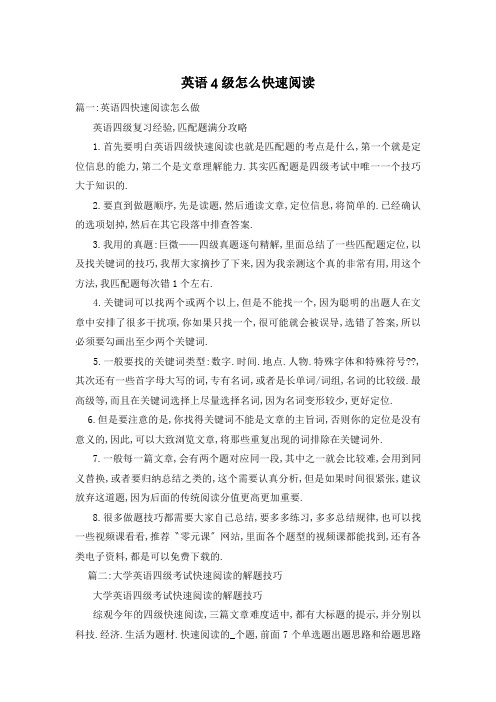
英语4级怎么快速阅读篇一:英语四快速阅读怎么做英语四级复习经验,匹配题满分攻略1.首先要明白英语四级快速阅读也就是匹配题的考点是什么,第一个就是定位信息的能力,第二个是文章理解能力.其实匹配题是四级考试中唯一一个技巧大于知识的.2.要直到做题顺序,先是读题,然后通读文章,定位信息,将简单的.已经确认的选项划掉,然后在其它段落中排查答案.3.我用的真题:巨微——四级真题逐句精解,里面总结了一些匹配题定位,以及找关键词的技巧,我帮大家摘抄了下来,因为我亲测这个真的非常有用,用这个方法,我匹配题每次错1个左右.4.关键词可以找两个或两个以上,但是不能找一个,因为聪明的出题人在文章中安排了很多干扰项,你如果只找一个,很可能就会被误导,选错了答案,所以必须要勾画出至少两个关键词.5.一般要找的关键词类型:数字.时间.地点.人物.特殊字体和特殊符号??,其次还有一些首字母大写的词,专有名词,或者是长单词/词组,名词的比较级.最高级等,而且在关键词选择上尽量选择名词,因为名词变形较少,更好定位.6.但是要注意的是,你找得关键词不能是文章的主旨词,否则你的定位是没有意义的,因此,可以大致浏览文章,将那些重复出现的词排除在关键词外.7.一般每一篇文章,会有两个题对应同一段,其中之一就会比较难,会用到同义替换,或者要归纳总结之类的,这个需要认真分析,但是如果时间很紧张,建议放弃这道题,因为后面的传统阅读分值更高更加重要.8.很多做题技巧都需要大家自己总结,要多多练习,多多总结规律,也可以找一些视频课看看,推荐〝零元课〞网站,里面各个题型的视频课都能找到,还有各类电子资料,都是可以免费下载的.篇二:大学英语四级考试快速阅读的解题技巧大学英语四级考试快速阅读的解题技巧综观今年的四级快速阅读,三篇文章难度适中,都有大标题的提示,并分别以科技.经济.生活为题材.快速阅读的_个题,前面7个单选题出题思路和给题思路与_年6月份和_月份完全保持一致.7个选择题非常明确,所有问题基本都可以从原文中找到答案,文中没有太多的长难句,句式结构以简单句为主,题干的线索词较明确,如一些公司名词,人名之类,只要考生能够按照题干中的关键词去文章中寻找,都可以顺利的找到与之对应的主题句,然后再同义转换就可以选出正确答案.最后三个填空题和去年相比难度大幅下降.一般来讲,填空题部分则需要考生能够看懂句子结构,并去判断和文章中原句做出比较,改变单词的词形填上适当的词或词组,而今年3个填空题根本没有出现任何一个选项需要去改变单词形式的情况.实际上,在那么短的时间里,读那么长的文章,别说做题了,就是读也读不完.那么我们就要提高阅读速度,加强阅读速度的训练.以前大家做阅读练习,要深刻理解文章的含义,要避免陷入文章陷阱,要根据题目重点看文章的段落,可是快速阅读由于考验的是大家的阅读基础,所以在文章中涉及的生疏单词比较少,陷阱也几乎没有.如果大家能有良好的阅读基础,能快速找到文章的重点信息;而不在无关信息上纠缠,速度自然就快了起来. 大纲规定, 在快速阅读篇幅较长.难度略低的材料时,阅读速度达到每分钟1_词.〝能基本读懂国内英文报刊,掌握中心意思,理解主要事实和有关细节.能读懂工作.生活中常见的应用文体的材料.能在阅读中使用有效的阅读方法.〞快速阅读部分要求考生在_分钟的时间内读完一篇1_0字左右的文章和后面的_道题.这里我们分析一下快速阅读的题型分类.解题技巧及解题步骤,希望对备战CET4的考生有一定的帮助.二.题型分类及解题技巧快速阅读对理解深度和层次要求不高,因此考试中通常只出现两种题型:主旨题和细节题.主旨题主要考查考生对所读文章主要轮廓.主要内容或中心思想等全局性问题的理解和把握;而细节题主要考查考生对细节问题如具体介绍.数字.步骤等局部性内容的理解.(一)主旨题的解题技巧如何迅速把握文章的主旨和作者的态度观点?通常文章一般分为三个类型.第一类型是开门见山型的文章,这种文章的主题和作者观点往往在第一段就有所交待.第二种类型是靶子型的文章,靶子型的文章里,第一段里讲述的是一个现象或者一种观点,在第二段里,作者表达出自己的不同看法.所以,这种类型的文章在第二段中才能够看到文章的主题和作者的观点.第三种文章是并行的两条线索,比如说对比美国和日本两国的企业文化差异等,这种类型的文章,主题相对来说稍微难把握一点,因为可能每个段落都散布着主题的一个分支,如果幸运的话,考生也许在最后一段能够看到一个综述,否则的话,要想获得主题,还要将每一个段落的小主题做一个叠加才能够获得一个全面的文章主题.因此,根据英文文章的写作特点,解答快速阅读的主旨题时要注意以下几点: ⒈ 快速阅读文章第一.二段,抓住文章大意.背景和作者风格,因为作者一般会在文章开头几段概述全文.⒉ 快速浏览找出每段的中心句和几件事实,抓住一两个关键词,如果文中段落大意没有用一句话总结,就自己归纳出大意,在可能蕴含全文主旨的部分进行仔细阅读. ⒊ 注意转折词和序列词,有助于我们了解文章的脉络.(二)细节题的解题技巧快速阅读文章后面的_道试题中大部分都是细节题,因此对细节题的解题技巧要熟练掌握.首先,确定自己要找的信息.在阅读文章之前,目光快速扫描一遍后面的题目.其次,了解文章的信息分布.可查读各章节小标题进行定位,确定可能含有所需信息的部分.最后,找出所需的具体信息.在已经定位的区域,快速阅读直至锁定答案.作细节题时,一定要在题中寻找定位词,回到原文去找答案的出处.要从文章里找到想要的信息,先要明白你想要什么信息,才能有的放矢.而为了寻找的方便,不可能把题目整个句子背下来,所以要划出尽量少但最有效的寻找依据. 在找依据的时候需要定位线索,需遵循以下原则:1. 形式最鲜明的专有名词和数字时间,而且多多益善.因为这些也有可能是不止一次出现,有两有两个或者以上,就能比较确定.要注意读出隐性的数字,也就是本身没有数字,但暗示文章里有数字.比如考题中In spite of safety considerations, the death rate on interstate highways is still higher than that of other American roads. Death rate当然可能用数字来表达.所以返回到原文去就会要去找有出现死亡率数字的地方.2. 如果没有如此鲜明的标志,还可以去找一些拼写很长,比较有特点的词组.不一定是意义最重要或者对文章最重要,而是在原文中最可能明确地找到.二.解题步骤(一)略读全文,浏览大标题,分析小标题浏览大标题的目的是为了对文章内容有大致的了解.而分析小标题则是为了把握文章的总体结构,了解文章内容的基本构成.如果阅读理解的篇幅较短,考试中可以直接用题目中的关键词汇定位,但是面对长篇累牍的快速阅读,考生首先应当留意文章当中是否有小标题.如果有,一定要先读小标题,因为小标题的作用如同目录,可以帮助考生宏观地把握文章框架,迅速寻找到有效信息的范围.有时文章没有小标题,这时须按下列顺序浏览全文:第一段的第一句.第二句和最后一句,以下每一段的第一句及最后一段的第一句和最后一句.这种方法,意味着已经开始阅读,所以花的时间要长一些,但应该控制在两分钟之内.(二)仔细读题,划出标志词或关键词标志词指的是专有名词(人名.地名.组织名.国名等)和数字等有标志性的单词,根据这些单词,我们可以对试题涉及的内容在文章中的位置进行快速定位.如果试题中没有标志词,那么就根据试题中的名词.名词词组.动词.动词词组.形容词和形容词词组确定试题提问的内容,然后再确定试题在文章中的位置.(三)答题在答题时,首先要根据标志词或关键词确定试题所在的部分,即在哪一个小标题下.如果文章没有小标题,也可以对试题在文章中的位置进行模糊定位.因为真题的出题顺序与原文的相关位置是一致的.也就是说,第四题答案的位置绝不会在第三题前面.因此我们答题时,最好不要一道题一道题地答,而要两道两道地做,前后呼应,能更好地定位.切记,快速阅读并不是为了阅读而阅读,而是为了做题而阅读.我们一定重视阅读的快速性.无声性及科学性,集中注意力,充满自信的去阅读.篇三:大学英语四级快速阅读答题技巧讲解大学英语四级快速阅读答题技巧讲解一.题型揭秘大纲规定本部分有两种考查题型,即判断正误题和单项选择题,每年从中选择一种题型进行考查.但需要我们注意的是_年6月以前快速阅读的设题方式为7道判断题加3道补全句子题,而_年_月以来的真题中前7道均为单项选择题,后3道为补全句子题.从近几年的出题倾向来看,单项选择题更能够考查出学生快速阅读的能力和水平,因此单项选择题成为近几年快速阅读考查的主要形式.考生在复习时要对这两种题型都有所了解,在平时的训练中把重点放在单项选择题上.▲ 二.阅读步骤第一步:略读全文,确定结构快速浏览文章的开头第一段以及各部分的小标题,搞清文章的大体结构和主要内容(一般都可以判断第一道主旨题目的答案)第二步:分析问题,原文定位顺序做每一道小题,正确理解题目所表达的内容,根据题目中的关键词——题眼,在文中找到相应的位置(可以将小标题.数字.人名等信息作为题眼)第三步:分解问题,填写准确●对于填空题,先看所缺的句子成分,然后根据小标题或者题眼找到原文.尽量照抄原文,但要抄得恰到好处,抄得简练,也就是说,题干问什么或缺什么,就抄什么,其余不相干内容不要抄上,保证所填内容的准确性1.主旨题的解题技巧根据英文文章的写作特点,解答快速阅读的主旨题时要注意以下几点:(1)快速阅读文章第一.二段,抓住文章大意.背景和作者风格,因为作者一般会在文章开头几段概述全文;(2)快速浏览找出每段的中心句和几件事实,抓住一两个关键词,如果文中段落大意没有用一句话总结,就自己归纳出大意,在可能蕴含全文主旨的部分进行仔细阅读;(3)注意转折词和序列词,有助于我们了解文章的脉络.用于快速阅读的文章,在通常情况下每个小部分会有一个小标题,这样对考生迅速阅读文章并掌握文章的主旨大意非常有帮助,考生要善于利用这一点.另外,因为文章和段落结构通常遵守某种体裁的结构模式,因此在快速阅读时,并不需要每句话都仔仔细细地阅读.2.细节题的解题技巧快速阅读文章后面的_道试题中大部分都是细节题,因此对细节题的解题技巧要熟练掌握. ●(1)首先,确定自己要找的信息.在阅读文章之前,目光快速扫描一遍后面的题目;(2)其次,了解文章的信息分布.可查读各章节小标题进行定位,确定可能含有所需信息的部分;(3)最后,找出所需的具体信息.在已经定位的区域,快速阅读直至锁定答案.大学英语四级快速阅读答题技巧讲解三:基本要求1. 快速阅读的文章基本都是专业题材的文章,很多考生可能会觉得很陌生,但是对于CET-4的快速阅读开始来说,只要求考生对题目所提到的信息在原文中能够找到即可,只是有时需要简单的同义词/同义短语替换2. 略读(Skimming)和寻读(Scanning)的能力在大学英语四级考试中显得尤为重要3. 快速阅读要求考生的阅读速度是每分钟1_-_0词快速阅读答题技巧▲答题技巧一: 详略得当对于大学英语四级快速阅读测试来说,根据题目的〝题眼〞快速在文章中找到答案是最关键的,这样我们就要在阅读时注意详略得当.克服精读精益求精的习惯,做到有信息处精读,无信息处略读,略读处一扫而过.对所要解释或证明的观点的细节举例处或者通常有数个名词的并列项,它们不是完整的主谓宾的句子,因此无法与问题对应的详细列举处,都可以略读.那么题目中数字.人名等信息(题眼)在原文中对应的部分必须详读.[例1] >原文中有这样一段:There are two ways to bury trash:? Dump — an open hole in the ground where trash is buried and that is full of various animals (rats, mice, birds). (This is most people’s idea of a landfill!)? Landfill—carefully designed structure built into or on top of the ground in which trash is isolated from the surrounding environment (groundwater, air, rain). This isolation is accomplished with a bottom liner and daily covering of soil.· Sanitary landfil l — landfill that uses a clay liner to isolate the trash from the environment · Municipal solid waste (MSW) landfill — landfill that uses a synthetic (plastic) liner to isolate the trash from the environment文章是对Dump和Landfill分别做了一个解释,这些就应该是考生略读的地方▲答题技巧二:显性信息查读的信息通常是显性信息,只要将问题在原文中进行准确定位就能得到正确答案,一般不需要做推理.▲答题技巧三:题文同序大学英语四级考试的快速阅读部分,问题顺序与原文顺序一致(有1-2题顺序不一致),这就要求考生应该按照题目的顺序依次做题,对于所有的四级快速阅读文章这个技巧都适用.▲▲答题技巧四:相关信息准确合并快速阅读文章中有时可能会问到所面临的问题是什么?某事情的原因是什么?等等,这样的问题在文中可能是在不同的位置都有表述,所以考生遇到这样的问题时,不能只局限在某一段里面找答案,可以先做后面的题目,在后面的阅读中发现还有该题的答案时,将相关信息合并后再确定答案大学英语四级答题技巧讲解快速阅读能力的提高固然有赖于考生在大量阅读中逐步的积累.但是,在平时的训练的时候,应该注意通过对逻辑关系(信号词).标点符号乃至一些特征语言信息点,乃至寻读等方法的积极运用,实现文章主旨的快速把握,对细节题的准确定位,对推理题的合理归纳.一.逻辑关系在快速阅读中的运用快速阅读理解能力的提高是有一定方法可循的,为此我们首先提示考生应该尤其注意文章逻辑关系在快速阅读中的运用.逻辑关系散布在文章的句子内部.句句之间.以及段落之间.最基本的逻辑关系有以下几种:1.因果关系:as a result ,therefore,hence,consequently,because, for, due to, hence,等等.2.并列.递进关系:and, or, then,in addition,besides,in otherwords,moreover等等.3.转折关系:however,but, yet, in fact等等.这些我们其实已经很熟悉的逻辑提示词在文章中起的效果,并非仅仅是衔接文章的句子,从阅读的角度来看,其实同时在给我们某种提示,告诉我们哪些句子是有效信息,相对重要的信息,哪些信息是相对不重要的信息,因为我们在处理文章的时候,有一条清晰的思路,你不是为了完整翻译文章而进行阅读,而是为了获取主旨来阅读.例如样题中的第一段:You have just finished your meal at a fast food restaurant and you throw your uneaten food, food wrappers, drink cups, utensils and napkins into the trash can. You don’t think about that waste again. On trash pickup day in your neighborhood, you push your can out to the curb, and workers dump the contents into a big truck and haul it away. You don’t have to think about that waste again, either. But maybe you have wondered, as you watch the trash truck pull away, just where that garbage ends up.▲我们注意到,在该段尾部出现了〝But〞.这里的〝But〞,说明作者陈述的内容的逻辑主旨发生了变化,因此,转折逻辑词之前的信息就变得不重要了,简单的处理方法是可以仅保留阅读转折词之后的信息.相应地,并列.递进关系词,意味着它们前后衔接的信息从主旨的体现上没有发生变化,而更多的表现为前后句子主旨的相似性,所以我们选择其中的一半进行阅读.这样,在保证了阅读质量的基础上,也极大地提高了阅读速度.如样题中〝How Is a Landfill Operated?〞一段中:Along the site, there are drop-off stations for materials that are not wanted or legally banned by the landfill. Amulti-material drop-off station is used for tires, motor oil, lead-acid batteries. Some of these materials can be recycled.In addition, there is a household hazardous waste drop-off station for chemicals(paints, pesticides, other chemicals) that are banned from the landfill. These chemicals are disposed of by private companies.注意到〝In addition〞,该词的出现意味着其后内容和上一段信息主旨基本一致,可以放弃本句的阅读.二.标点符号在快速阅读中的运用可以运用标点符号(破折号.小括号.冒号)了解不认识的词汇或句子的含义.因为这些标点符号的出现就是为了更进一步地其前的信息.但同时,由于快速阅读用词相对比较简单,很容易理解和把握标点前的被解释信息,所以,可以将这些标点符号后面的信息删除,从而更加快速地把握文章的主旨.例如样题中有下列信息:Dump—an open hole in the ground where trash is buried and that is full of various animals (rats, mice, birds). (This is most people’s idea of a landfill!)Landfill—carefully designed structure built into or on top of the ground in which trash is isolated from the surrounding environment (groundwater, air, rain). This isolation is accomplished with a bottom liner and daily covering of soil.? Sanitary landfill—land fill that uses a clay liner to isolate the trash from the environment? Municipal solid waste (MSW) landfill—landfill that uses a synthetic (plastic) liner to isolate the trash from the environment。
英语四级答题方法技巧

英语四级答题方法技巧高校英语四级考试对高校生来说是很重要的一次考试,答题不仅要求专业到位,一些答题技巧也是必不行少的。
下面是我为大家整理的关于英语四级答题方法技巧,盼望对您有所关心!英语四级答题小技巧一、四级阅读四级速读:一看二查三圈点。
一看,看题干关键词!找特别名词或词组。
二查,查阅关键词对应句。
当句子失效时查段落首末句,尤其是末句!20_年6月七道选择题五道答案在末句!三圈点,圈点句中动词和名词!正确答案的特点,是核心动词和名词与原句完全全都或至少词义接近。
四级精读:①先看题(what,why,to,view)②划题干独特信息回原文找出处,特殊关注:因果并列比较转折结论建议性表达③用原文信息对比选项信息,对原文做精确改写,形式对应(并列对并列,比较对比较)含义对应(同义替换词)的选项最优选.记背历年真题正确选项与原文的同义替换词是捷径!四级选词填空:①选项分词性n.v.a.ad.②依据每空前后信息推断词性③把对应词性选项逐一带回原文,含义通顺,时态主谓搭配全都者为正确答案.历年真题中选词填空/完形填空/态度题的选项复合式听写的单词都可能成为下次的`备选选项.考试中把选词填空放到最终做,充裕时间留给精读.二、四级听力四级短对话:1、看题时关注谓语宾语表语(动词形容为先)并勾划;2、对立或相像选项保留;3、急速预备校内餐厅酒店等必考场景;4、听其次句、听语气态度转折动作;5、包含同义替换词语的选项胜利系数最大;6、救命原则:视听反向,听到的不选。
四级长对话:关注男女两人语气,把握大方向;七道题中,试听全都原则可以解答出四道题目左右;对话的替换法比较简洁,一般是词性替换(popular-populairty)和简洁词义替换(be fed up with - be tired of ):较短选项的题目利用重复法,亦即读最多遍的选项为正确答案。
四级短文听力:四级短文听力:1纵向扫选项,划出不一样的谓语宾语表语部分;2挨次出题,绝大部分题听到什么选什么,少数同义替换解题;3疑问语气和因果转折关系词(because,but,etc)后极易出考点;4边听边做!不等问题!四级复合式听写:1预看题时筛出已给段落高频词,极易在后三个句子中消失2预判前八空中可能填名词和动词的题,稍后重点关注其单复数或时态3三个句子听到什么写什么,首尾部分最易写出,抄写时尽量修改补全使之成为完整句子4针对复合式听写的优先单词储备三、四级完形完形填空:四六级通用!1严峻做好近三年真题;2先看各段首句把握重复信息,了解主旨;3挑题做:按介词、连词、并列连词旁边、和历史重现考题挨次来做;4检查段首句和文章中重复信息!最终,争取把近三年考过的生词背下来!就是背答案!四、四级写作和翻译写作:_年6月四级写作关注对立观点分析型。
2021年12月英语四级考试快速阅读答案(网友版)
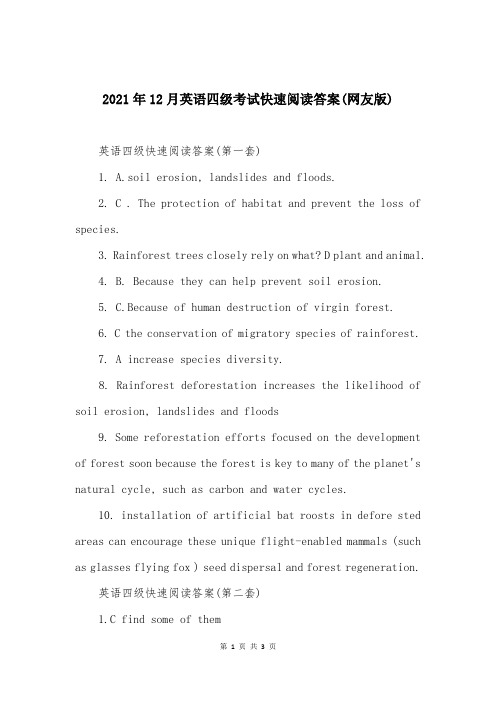
2021年12月英语四级考试快速阅读答案(网友版)英语四级快速阅读答案(第一套)1. A.soil erosion, landslides and floods.2. C . The protection of habitat and prevent the loss of species.3. Rainforest trees closely rely on what? D plant and animal.4. B. Because they can help prevent soil erosion.5. C.Because of human destruction of virgin forest.6. C the conservation of migratory species of rainforest.7. A increase species diversity.8. Rainforest deforestation increases the likelihood of soil erosion, landslides and floods9. Some reforestation efforts focused on the development of forest soon because the forest is key to many of the planet's natural cycle, such as carbon and water cycles.10. installation of artificial bat roosts in defore sted areas can encourage these unique flight-enabled mammals (such as glasses flying fox ) seed dispersal and forest regeneration.英语四级快速阅读答案(第二套)1.C find some of them2. B relieve pressure3. A to listen to4. B to put every task5. C) Enjoy doing gardening6. C stress better7. A) one should escape8. recharge and reflect yourself9. supportive friends10. a strong spirituality英语四级快速阅读答案(第三套)1.showman2.she started3.he keen4.one5.an inspire6.he command7.many8.closed and inflexiblebined10.putting a diny in the universe英语四级快速阅读答案(第四套)快速阅读 should sugar:D C A A D B Cshould sugar:43114238题hazards9题tightened10题 slightly more convenient。
英语四级快速阅读和仔细阅读
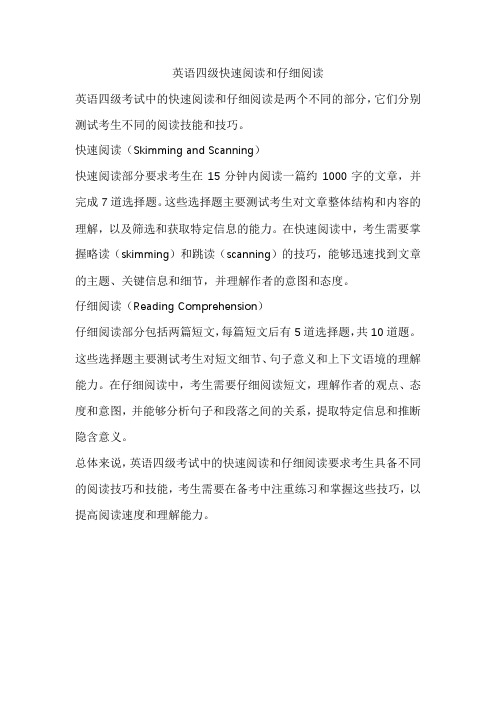
英语四级快速阅读和仔细阅读
英语四级考试中的快速阅读和仔细阅读是两个不同的部分,它们分别测试考生不同的阅读技能和技巧。
快速阅读(Skimming and Scanning)
快速阅读部分要求考生在15分钟内阅读一篇约1000字的文章,并完成7道选择题。
这些选择题主要测试考生对文章整体结构和内容的理解,以及筛选和获取特定信息的能力。
在快速阅读中,考生需要掌握略读(skimming)和跳读(scanning)的技巧,能够迅速找到文章的主题、关键信息和细节,并理解作者的意图和态度。
仔细阅读(Reading Comprehension)
仔细阅读部分包括两篇短文,每篇短文后有5道选择题,共10道题。
这些选择题主要测试考生对短文细节、句子意义和上下文语境的理解能力。
在仔细阅读中,考生需要仔细阅读短文,理解作者的观点、态度和意图,并能够分析句子和段落之间的关系,提取特定信息和推断隐含意义。
总体来说,英语四级考试中的快速阅读和仔细阅读要求考生具备不同的阅读技巧和技能,考生需要在备考中注重练习和掌握这些技巧,以提高阅读速度和理解能力。
- 1、下载文档前请自行甄别文档内容的完整性,平台不提供额外的编辑、内容补充、找答案等附加服务。
- 2、"仅部分预览"的文档,不可在线预览部分如存在完整性等问题,可反馈申请退款(可完整预览的文档不适用该条件!)。
- 3、如文档侵犯您的权益,请联系客服反馈,我们会尽快为您处理(人工客服工作时间:9:00-18:30)。
Can Digital Textbooks Truly Replace the Print Kind?The pain pointsshortcomings of traditional print edition textbooks are obvious: For starters they’re heavy, with the average physics textbook weighing in at a burdensome 3.6 pounds. They’re also expensive, especially when you factor in the average college student’s limited budget, typically costing hundreds of dollars every semester.But the worst part is that print versions of textbooks are constantly undergoing microscopic revisions. Many professors require that their students use only the latest versions in the classroom, essentially rendering older texts unusable. For students, it means they’re basically stuck with a four pound paperweight that they can’t sell back(and even if they can, it’s f or a fraction of the cost)..Which is why digital textbooks, if they live up to their promise, could help alleviateease many of these pain pointsshortcomings. But till now, they’ve been something akin tolike a mirage(幻影) in the distance, more like a hazy(模糊的)dream than an actual reality. Imagine the promise: Carrying all your textbooks in a svelt 1.3 pound iPad? It sounds almost too good to be true.But there are a few pilot schools already making the transition(过渡)over to digital books. Universities like Cornell and Brown are among the Ivies to have jumped onboard. And one medical program at the University of California, Irvine, gave their entire class iPads with which to download textbooks just last year.But not all were eager to jump aboard.“People were kindtired of weary to useusing the iPad textbook besides using it for reading,” says Kalpit Shah, who will be going into his second year at Irvine’s medical program this Fall.”“They weren’t using it as a source of communication because they couldn’t read or write in it. So a third of the people in my program were using the iPad in class to take notes, the other third were using laptops and the last third were using paper and pencil.”The reason it hasn’t caught on yet, he tells me, is that tablet the functionality of e-edition textbooks are exactly that: flat PDF-like files on the screen. Their functionality is incredibly limited, and less tech savvysome students just aren’t motivated to learn new study behavior.But a new appapplication called Inkling might change all that. The company just released an updated version last week, and it’ll be utilized in over 50 undergradundergraduate and graduate classrooms this coming school year.“Digital textbooks are not going to catch on,” says Inkling CEO Matt MacInnis as he’s giving me a demo over coffee. “What I mean by that is the current perspective of the digital textbook is it’s a replicaan exact copy of the print book. And people have been trying to do this for 10 years already.There’s Course Smart, etc., these guys who take an image of the page and put it on a screen. If that’s how we’re defining digital textbooks, there’s no hope of that becoming a mainstream product.”He calls Inkling a platform for publishers that allows them to build rich multimedia content from the ground up, with a heavy emphasis on real-world functionality. The traditional textbook, at least in this case, merely serves as a skeleton.At first glance Inkling is an impressive experience. After swiping into the iPad app, which you can get for free here, he opens up a few different types of textbooks.Up first is a chemistry book. The boot time is pretty fast, and he navigates through(浏览) a few chapters before swiping into a fully rendered 3D molecule that can be spun around to view its various building blocks. “Publishers give us all of the source media, artwork, videos (stuff that’dnormally be in a CD attachment or online),,” he says. “We help them think through how to actually build something for this p latform.”Next he pulls up a music composition textbook, complete with playable demos. He clicks into a diagram of staff notation, which he then clicks on to play a listenable piano sonata.It’s a learning experience that attacks you from multiple sensory directions, taking out a lot of the heady guess work. It’s clear why this would be something a music major would love.But the most exciting part about Inkling, to me, is its innovative notation(批注) system. Here’s how it works:When you purchase a used pri nt book, it comes with its previous owner’s highlights and notes in the margins. It leveragesuses the experience of someone who already went through the class to help honeimprove your reading (how much you trust each notation or not is obviously up to you). But with Inkling, you can highlight a piece of content and annotate it withmake notes. Here’s where things get interesting, though: If a particularly important passage is highlighted by multiple Inkling users, that information is stored on the cloud and is available for anyone reading the same textbook to come across. That means users have access to notes from not only their classmates and Facebook friends, but anyone who purchased the book across the country. The best comments are then sorted democratically by a voting system (sort of like a Reddit upvote),, meaning that your social learning experience is shared with the best and brightest thinkers.As a bonus, professors can even chime in(插话) on discussions as designated “experts.”. They’ll be able to answer the questions of students who are in their class directly via the interactive book. Of course, Inkling addresses several of the other pain points prevalentshortcomings in traditional print as well. Textbook versions are constantly updated, incentivizingmotivating publishers by minimizing production costs (the big ones like McGraw-Hill are already onboard). Furthermore, students will be able to purchase sections of the text instead of buying the whole thing, with individual chapters costing as little as $2.99.There are, however, challenges.“It takes elbow greaseefforts to build each book,”MacInnis tells me. And it’s clear why.Each interactive textbook is a media-heavy experience built from the ground up, and you can tell that: it takes a respectable amount of manpower to put together each one.For now the app’s also iPad-exclusive, and though a few of these educational institutions are giving the hardware away for free, for other students who don’t have such a luxury it’s an added layer of cost—and an expensive one at that.But this much is clear: The traditional textbook model is and has been broken for quite some time. Whether digitally interactive ones like Inkling actually take off or not remains to be seen, and we probably won’t have a definitive answer for the next few years.However, the solution to any problem begins with a step in a direction. And at least for now, that hazy mirage in the distance? A little more tangible,(可触摸的), a little less of a dream.。
